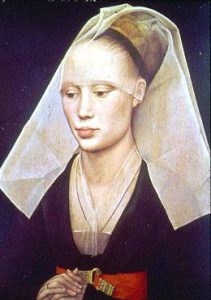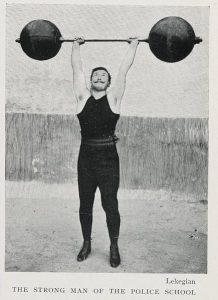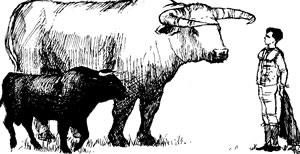Our Great Mother advises us to cherish in our hearts paired qualities—four pairs, suited to the four great sabbats. Perhaps I am accepting the obvious, yet these first two qualities resonate with Beltane energies.
Beauty…Shines
…let there be beauty and strength, power and compassion, honour and humility, mirth and reverence within you.
—the Charge of the Goddess
What Is Beauty?
Rogier van der Weyden, Portrait of a Lady, c. 1460,
This oft-repeated phrase was rebooted into popular vocabulary by its reference as most of the title of a surrealistic episode of the Twilight Zone (1960), “Eye of the Beholder,” almost a century after it was first framed in these words in an 1878 tale by an Irish romance novelist (Molly Bawn, Margaret Wolfe Hungerford). The sentiment goes back to Shakespeare and millennia further back into ancient Greece. To explicate the phrase, beauty is a subjective judgement made individually.
Iman 20th century
Our society thinks of beauty, first of all, as a trait of the female of our species. Today, supermodels, from 1960s’ Twiggy to 1990s’ Imam, are held up as beauties. Historically, women in power are regarded as role models for fashion—Queen Elizabeth I (Good Queen Bess), nicknamed Gloriana, overturned female styles from the dark hues and blocky silhouettes of Queen Mary Tudor, her predecessor, to the whites and pale tints, lace trims & ruffs, and floral decoration throughout her
reign, bringing a brightness into fashion.
In today’s world, beauty is made cheap. From glamour and fashion magazines of the past century to today’s reality television shows, ordinary humans are “discovered“ and made famous…at least for their allotted 15 minutes of fame. In these fora, human physical attractiveness is valued higher than almost any other human quality, mental or physical—exposing such beauty as very nearly valueless. Empty beauty becomes a goal in itself or a tool to enable instant wealth or fame or both. And advertisers tout everything from the lowest-cost cosmetics to the highest-cost cosmetic surgeries in these same media.
The word beauty itself is introduced into English in the 13th century from Old French, by way of the Norman Conquest, deriving ultimately from Latin. It is defined in its earliest English meaning as “the quality (or aggregate of qualities) in a person or thing that gives pleasure to the senses or pleasurably exalts the mind of spirit.”
—Merriam-Webster New Collegiate Dictionary, 10th edition
Yes, it’s a long-winded definition, necessarily so. Abstract concepts are always difficult to define by comparison with anything concrete, where one can see or touch or point at it and say, “see? that’s quality–what-have-you.”
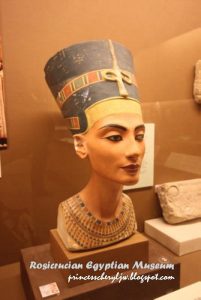
Nefertiti, Egyptian queen, 14th century BCE
Many dictionaries resort to defining such words with a synonym for the word, making it easier on the compilers but much harder on the readers who may not know the meaning of the synonyms any more than they knew the word they looked up. An example of such definitions might lead one to — beauty: handsomeness: attractiveness: charm: charisma: glamour: beauty—a circular puzzle with no definition. So, looking at the definition as simply as possible, beauty is the aspect(s) of anyone or anything which pleases the senses or the spirit. Beauty lifts human hearts or souls; it attracts our eyes, ears, noses, mouths, or hands by giving pleasure. The word beauty supplanted the pre-Conquest word white (Old English/ Anglo-Saxon, itself defined as beauty or splendour.
Me, I find splendour a meaningful alternative to the much overused, not to say abused, modern usage of the word beauty. Beauty attracts the senses or the spirits, and a brilliance or shining or vividness is among the most common qualities that attract. And, lo, the very word splendour derives from the Latin to shine. In heraldry, in fact, the sun in splendour is depicted with eight or sixteen rays surrounding a central disk having facial features, thus:

“the sun in splendour” medieval & heraldic term for the stylised depiction of the sun
Beauty Without
Splendour, shining, brilliance—all of these qualities are cherished in the world around us.
Sunsets and sunrises, rainbows and moonshine, mountainous vistas reflected upon still and moving water, brilliant swathes of spring wildflowers—all of these are among what we call beautiful. As interest in natural history arose in the 18th century, the term picturesque came into use, referring to natural vistas worthy of being painted. Young ladies of rank were universally educated in drawing and watercolours to record images and scenes for themselves and others, similar to the way the Kodak Brownie camera enabled early 20th century families to collect snapshots of people and places, just as smartphones and digital cameras enable today’s youth to populate such websites as Shutterfly, Flickr, and Pinterest with places and people and events.
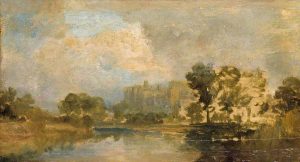
Windsor Castle from the River—Turner
 Bridal Veil Falls, Multnomah Falls, Oregon
Bridal Veil Falls, Multnomah Falls, Oregon
The 18th century UK landscape contrasts with the US photograph, at the same time as they are both picturesque. Both have qualities of light that attract the eye, that glow or shimmer or shine. It is not only landscapes that draw our eyes in this way.
Moonbow over the island of Hawaii
Symmetry and brilliance provide instances of uplifted emotion and indrawn breath as we indulge our gaze thereon.
Beauty in the Occult
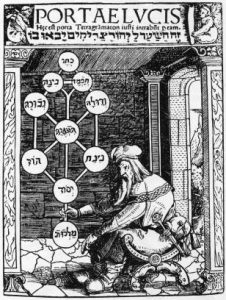
16th-century depiction, Jewish Tree of Life
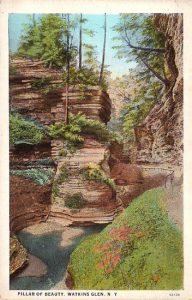 Pillar of Beauty Watkins Glen State Park, NY
Pillar of Beauty Watkins Glen State Park, NY
The foundation taught in the kabbalah (Jewish medieval mystery tradition) or cabala (Christian renaissance mystery tradition) or qabala (Hermetic magical tradition) concerns the Tree of Life, depicted as ten spheres interconnected by 22 pathways, key among which are the three vertical pathways called (reading from left to right):
the Pillar of Beauty
the Pillar of Wisdom
the Pillar of Strength
Beauty here is set in contrast to Strength, with the middle pillar being Wisdom. Whichever spelling of kabbalah one chooses to use, most Western Mystery Traditions have, for more than twelve hundred years, employed concepts from the mystical Tree of Life and its components.
Freemasonry terms these upright pillars—Beauty, Wisdom, Strength—as the pillars on which the lodge stands, so intrinsic a foundation principle of Masonry that these pillars are referenced in esoteric Western traditions of every sort. In the 18th century North American British colonies, a great many of what today are called America’s founding fathers were Freemasons; one can only presume that such a Mason named the physical feature in New York state—the “Pillar of Beauty” (illustration, vintage postcard).
Tarot’s major arcana or greater trump cards comprise a total of twenty-two card (numbered zero through twenty-one), mirroring the 22 pathways among Tree of Life. Given that these trionf cards, as they are known in the earliest surviving tarot decks (such as the Visconti-Sforza), it is not known with any certainty whether the greater trumps number 22 for that reason, or for some other. The kabalic references depicted in more modern tarot decks, such as the Rider-Waite or Universal Rider decks, derive from esoteric teachings that associate the greater trumps with the kabala over the prior century and more.
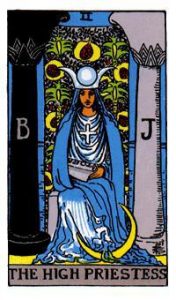
major arcana II, High Priestess, Rider-Waite deck, 1900 CE
The Tarot’s High Priestess card (number II of the greater trumps) traditionally depicts the High Priestess seated between the Pillar of Beauty and the Pillar of Strength—implicitly displaying the High Priestess herself as the Pillar of Wisdom.
(The B & J shown on the pillars in the card illustrated here refer to the Hebrew initials for each pillar, transcribed into Latinate letters.)
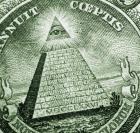 All-seeing eye on US $1 bill, obverse
All-seeing eye on US $1 bill, obverse
Masonic symbols appear throughout our U.S. symbology; even today the all-seeing eye or the Eye of Providence (a common Masonic symbol) appears above an unfinished pyramid on the obverse of the one-dollar banknote printed by the U.S. Mint.
Beauty Within
“No spring nor summer beauty hath such grace, as I have seen in one autumnal face.” —John Donne
This classic quote speaks to the quality of beauty that transcends surfaces and the modern insistence on youthful appearance. Donne uses the word grace to evoke in his reader’s minds the qualities that embody the inner beauty of wisdom, courtesy, kindness, goodness, nobility, and so on. True beauty is found in the spirit and shines for all to see. When the Goddess tells us to have beauty within us, She evokes this greater beauty which benefits each of Her hidden children for themselves —and also for everyone else around them. The Wicca know (as do all wise magic-users) that Thus, we all are charged to seek out one’s own beauty within and to cherish its growth in each of us.
Strength…Abides.
Strength…Abides
What is Strength?

Charles Atlas, mid-20th cent. bodybuilder
An early picture of a strong man.. 1906
Strength is a quality—being strong—which may apply to individual humans or animals or objects, groups of humans or animals or objects, or even entire tribes or species or categories of objects. Among humans, definitions of strength or strong cover a gamut of meanings, from the ability to wield ergs that move tonnes, to the inner qualities that enable humans to endure privation and withstand hardship, to the stalwart temperaments displayed variously as stubbornness, loyalty, and tenacity. Families or tribes or entire peoples may be called strong, with any of the meanings of the term.
Strength Without
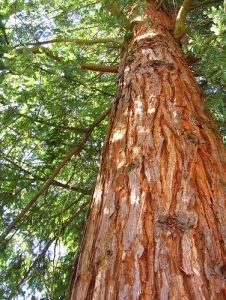
Western red cedar (Thuja plicata)
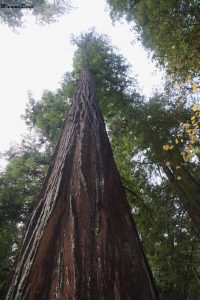 Coast redwood (Sequoia sempervirens)
Coast redwood (Sequoia sempervirens)
Natural strength exists in the world around us, in the boles of trees, the solidity of stone, the force of foods, the vigour of wildlife, and the extremes of weather. From the Stone Age onwards, humankind has used the strength of stone in structures and tools and weapons. Flint or obsidian blades, cobble and thatch homes, slate pathways, slung stones—we value the strength of stone, just as we use its mountains and crags as landmarks for our travel. The climax species of conifer that once comprised the backbone of the widespread coastal temperate forests of western North America (cedar and redwood) depict their own “pillars of strength.”
Whether coniferous or broadleaf, mature climax forests feature such wondrous pillars, be they the pictured cedars and redwoods of western lands, or the oaks, beeches, maples, and birches of eastern ones. These sturdy columns support huge widespread foliate canopies which, astonishingly, act as solar engines to renew our air, circulate our water, distribute chemical nutrients, and shelter our wildlife.

Scots river in food
Greek mythology, in the Labours of Hercules, tells us how he used his strength to re-route two rivers in food through the Augean Stables to clean them out in a single day. The “force of foods” required all his Herculean strength to manipulate, while accomplishing what even he could not perform in one day, moving a veritable mountain of manure.
 Pillars of Hercules (Straits of Gibraltar) View from Gibraltar lighthouse across the straits to Jebel Musa, N. Africa
Pillars of Hercules (Straits of Gibraltar) View from Gibraltar lighthouse across the straits to Jebel Musa, N. Africa
Even today, the Atlantic passage to the Mediterranean Sea which we call the Straits of Gibraltar, are also known as the Pillars of Hercules, just as they were known to Phoenician traders and Greek sailors. Two mountains bracket the gap through which the Atlantic replenishes the waters of the Mediterranean, the rock of Gibraltar at the southern tip of Spain, and Jebel Musa, in Morocco at the northern tip of North Africa. Given that Hercules’ fame arose from his strength and tenacity, the Pillars of Hercules were and remain symbols of both.
Strength in the Occult
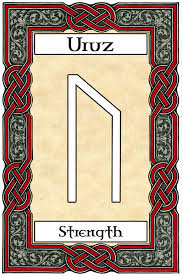
Uruz rune
As many occultists know, the Pillar of Strength is described as the pair to the Pillar of Beauty, with the Pillar of Wisdom between the two. Rather than repeat kabala material, let me turn to another significant strain of esoteric lore, the Norse runes. Runes, like scripts everywhere, were known only to a few at first. The art of writing was generally considered magical, or at least sacred, during its early days within any culture. In the mythology of the Norse, Odin (often called All-Father), chief of the gods of the Norse pantheon, hung for nine days on Yggdrasil (the mythical World-Tree that connects the Norse three realms: underworld, earth, and overworld) to obtain the knowledge of the runes, or writing, and share them with his followers. These 24 runes of the futhark are both the alphabet of the Norsemen and were—and are—used extensively for divination and in magical inscriptions. (Why futhark? because the first six runes are the letters: F, U, TH, A, R, and K. A close parallel to our word alphabet, which derives from the Greek names of the first two letters, alpha and beta.)
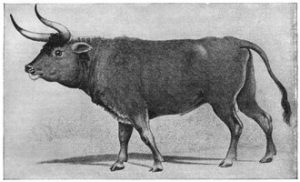
Aurochs bull reproduction from skeletal find
The Uruz rune is often known as the rune of strength: this second rune of the futhark, Uruz in the futhark of Old Norse represents the letter U and means aurochs, the primitive giant wild Eurasian cattle.
Sketch comparing bull aurochs & bull cattle with human of ~5’9″ for scale
Aurochs, especially bull aurochs, were fearsome animals, about 150% of the size of a modern beef bull, with shoulder heights of seven to upwards of nine feet. Although ancestor to modern domestic cattle (the last aurochs died in Poland in 1627 CE), aurochs were not domesticated nor tractable, being hunted to extinction, rather than husbanded & bred.
Strength Within
“Strength of mind is exercise, not rest.” —Alexander Pope
Humans use the strength of mind to determine our purposes. We use our strength of will to hold constant to those purposes. And we use our strength of body to act for those purposes. The common trait among them all—following Pope’s epigram—is the exercise of our minds to select among options consciously, to hold fast to those decisions and to select course(s) of action that makes those choices come to pass. Just as the Goddess advises us to have the strength within us, so do our gods advise us to choose our intent: “An it harm none, do as thou wilt.” Opt to do, or not to do, a familiar concept.
“Do, or do not.” —Yoda, Star Wars
Finally, there’s strength of character. Our gods also advise us to be responsible for what we do, “As thou dost give, so shall ye gain.” What goes around, comes around; equally familiar as Newton’s third law, “for every action there is an opposite reaction.” Strong characters reflect self-knowledge, own errors, redress wounds, enable trust… absolutely foundational needs for any magic worker!
Deborah Snavely
References (Wikimedia, unless mentionted otherwise):
Rogier van der Weyden, Portrait of a lady, c. 1460,
from nyfalls.com web site, image of pre-WWI vintage postcard, artist unknown
Moonbow over Kilauea lava flow, here is published source with photo credit, I used a clip there from Huffington post
Bridal Veil Falls, part of Multnomah Falls, Oregon
from nyfalls.com web site, image of pre-WWI vintage postcard, artist unknown
Early pic of a police strong man…1906
Gibraltar lighthouse showing opposite “pillar of Hercules” across the straits

